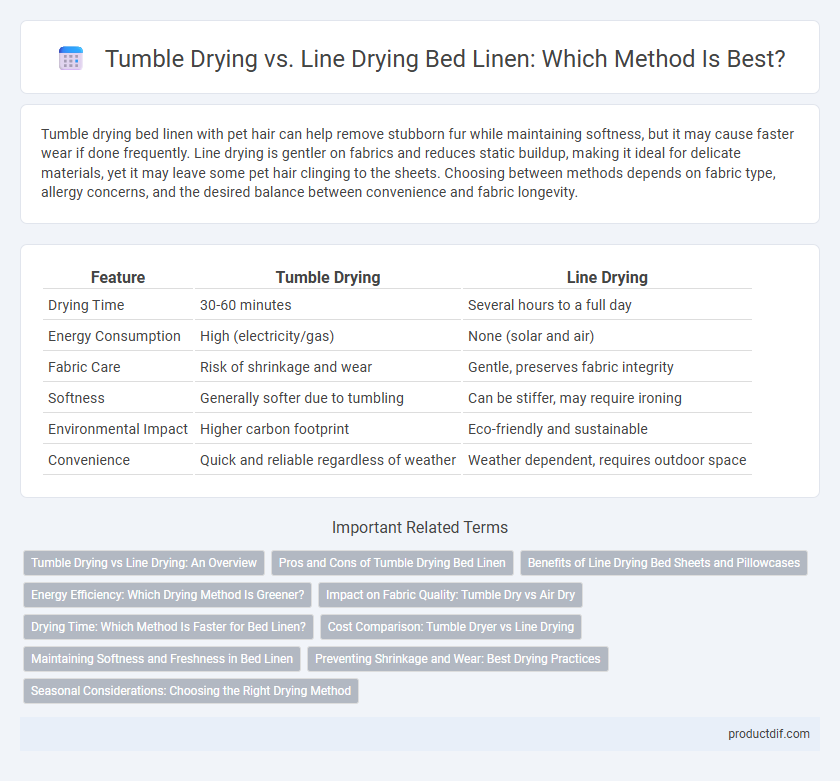Tumble drying bed linen with pet hair can help remove stubborn fur while maintaining softness, but it may cause faster wear if done frequently. Line drying is gentler on fabrics and reduces static buildup, making it ideal for delicate materials, yet it may leave some pet hair clinging to the sheets. Choosing between methods depends on fabric type, allergy concerns, and the desired balance between convenience and fabric longevity.
Table of Comparison
| Feature | Tumble Drying | Line Drying |
|---|---|---|
| Drying Time | 30-60 minutes | Several hours to a full day |
| Energy Consumption | High (electricity/gas) | None (solar and air) |
| Fabric Care | Risk of shrinkage and wear | Gentle, preserves fabric integrity |
| Softness | Generally softer due to tumbling | Can be stiffer, may require ironing |
| Environmental Impact | Higher carbon footprint | Eco-friendly and sustainable |
| Convenience | Quick and reliable regardless of weather | Weather dependent, requires outdoor space |
Tumble Drying vs Line Drying: An Overview
Tumble drying bed linen offers faster drying times and softness due to consistent heat and agitation, making it suitable for busy households. Line drying, by contrast, preserves fabric integrity and reduces energy consumption, promoting eco-friendly and cost-effective care. Selecting between tumble drying and line drying depends on balancing convenience, fabric care, and environmental impact.
Pros and Cons of Tumble Drying Bed Linen
Tumble drying bed linen offers the advantage of quick drying time, which is especially useful for maintaining household efficiency and convenience. However, frequent use can lead to fabric wear and shrinkage, reducing the lifespan and softness of cotton and linen materials. Energy consumption is higher with tumble dryers compared to line drying, making it a less eco-friendly option for sustainable home practices.
Benefits of Line Drying Bed Sheets and Pillowcases
Line drying bed sheets and pillowcases preserves fabric integrity by reducing exposure to high heat, which minimizes wear and prolongs the lifespan of cotton and linen materials. Exposure to natural sunlight during line drying also acts as a natural disinfectant, helping to eliminate bacteria and allergens, resulting in fresher, cleaner bedding. Furthermore, air-drying reduces energy consumption and environmental impact compared to tumble drying, making it an eco-friendly choice for maintaining bed linen quality.
Energy Efficiency: Which Drying Method Is Greener?
Line drying bed linen uses no electricity, making it the most energy-efficient and eco-friendly drying method by reducing household carbon emissions. Tumble drying consumes significant energy, often relying on non-renewable power sources, which increases environmental impact. Choosing line drying not only saves energy but also prolongs the lifespan of bed linens by avoiding heat damage.
Impact on Fabric Quality: Tumble Dry vs Air Dry
Tumble drying can cause fabric fibers in bed linen to weaken and fade faster due to the high heat and constant tumbling motion, leading to reduced durability over time. In contrast, line drying preserves the fabric quality by preventing excessive wear and maintaining color vibrancy, as the gentle air-drying process minimizes fiber stress. Choosing air drying extends the lifespan of bed linen by protecting the material's softness and structural integrity.
Drying Time: Which Method Is Faster for Bed Linen?
Tumble drying significantly reduces drying time for bed linen, often completing the process in 30 to 45 minutes compared to several hours or even a full day required for line drying. The heat and tumbling action in dryers speed up moisture evaporation, making it the preferred method for quick turnover. Line drying relies on air circulation and sunlight, which, while energy-efficient and gentle on fabrics, extends the drying time substantially.
Cost Comparison: Tumble Dryer vs Line Drying
Tumble drying bed linen consumes significantly more energy, resulting in higher utility bills compared to line drying, which uses no electricity and relies solely on natural air and sunlight. On average, a single tumble dry cycle costs around $0.30 to $0.50, whereas line drying is free but may take longer, potentially affecting convenience and turnaround time. Long-term cost analysis favors line drying for energy savings, while tumble drying incurs ongoing expenses due to electricity consumption and appliance maintenance.
Maintaining Softness and Freshness in Bed Linen
Tumble drying bed linen preserves softness by preventing stiffness that often occurs with line drying, which can leave fabrics feeling rough and less comfortable. Line drying exposes linens to fresh air and sunlight, helping to naturally deodorize and maintain a crisp, clean scent without the risk of heat damage. Combining air drying with low-heat tumble cycles can enhance both freshness and fabric softness, extending the life and comfort of your bed linen.
Preventing Shrinkage and Wear: Best Drying Practices
Tumble drying bed linen at low heat settings minimizes shrinkage by controlling temperature and moisture exposure, preserving fabric size and softness. Line drying slows wear by reducing mechanical agitation and heat stress, extending linen durability and maintaining thread integrity. Combining gentle tumble drying with air drying between uses balances convenience with fabric longevity, making it the best practice for preventing shrinkage and wear.
Seasonal Considerations: Choosing the Right Drying Method
Tumble drying bed linen during colder months helps prevent dampness and maintains softness, while line drying in warm, sunny seasons saves energy and naturally freshens fabrics. Seasonal humidity levels influence drying times and fabric care, with lower humidity favoring outdoor drying for reduced static and wrinkle formation. Selecting the appropriate drying method based on temperature and moisture conditions enhances bed linen longevity and comfort.
Tumble Drying vs Line Drying Infographic

 productdif.com
productdif.com